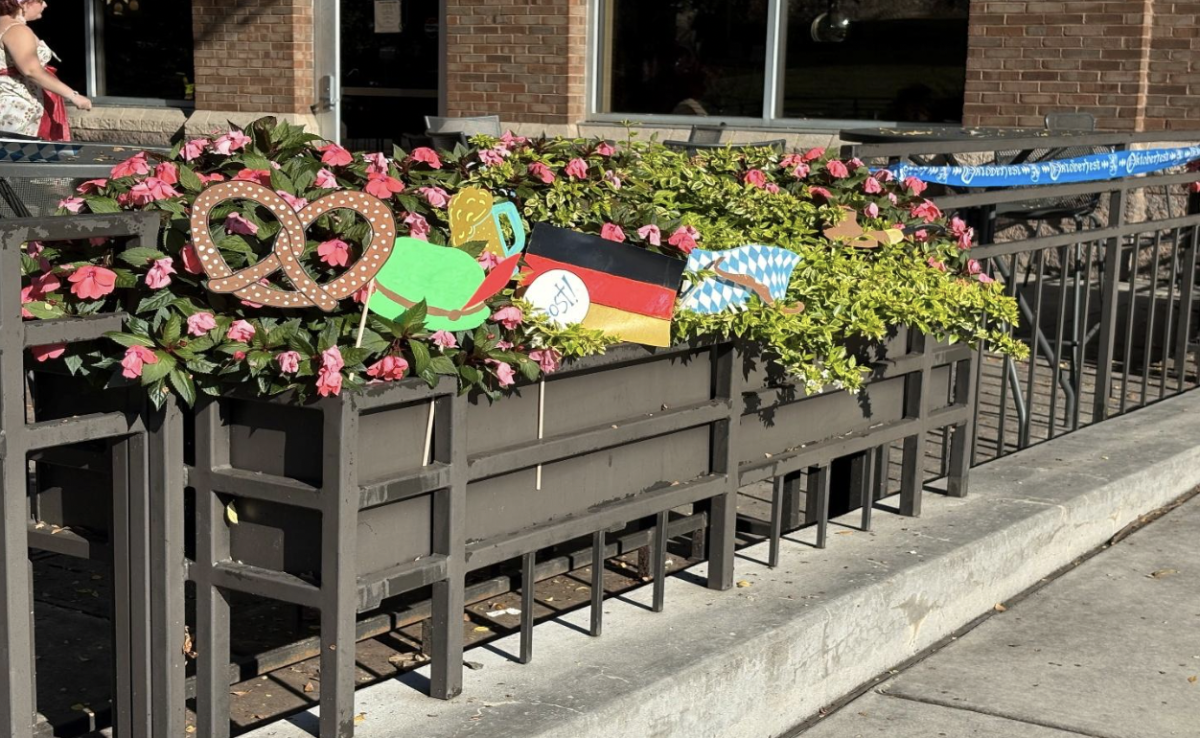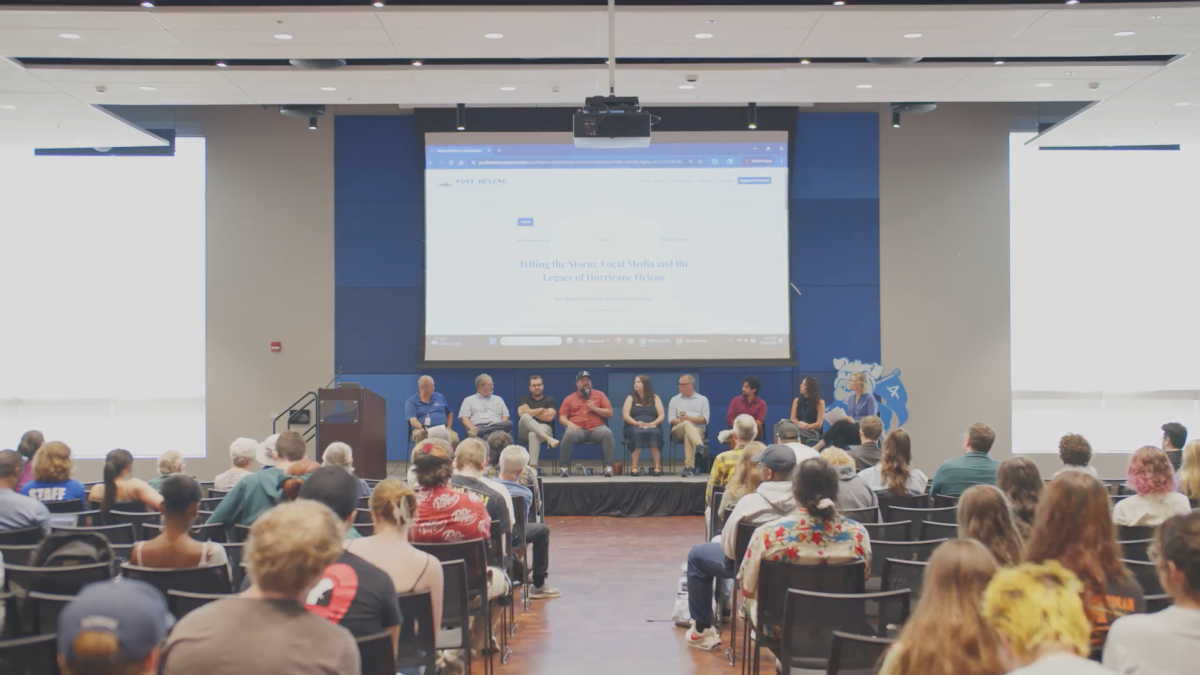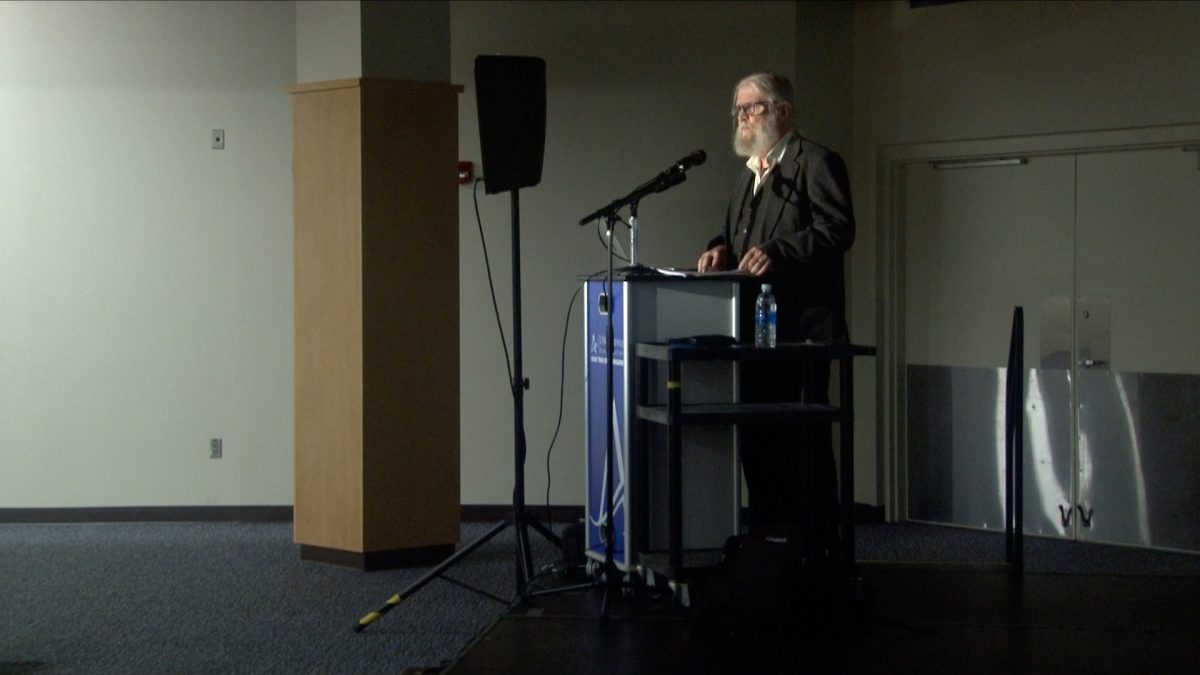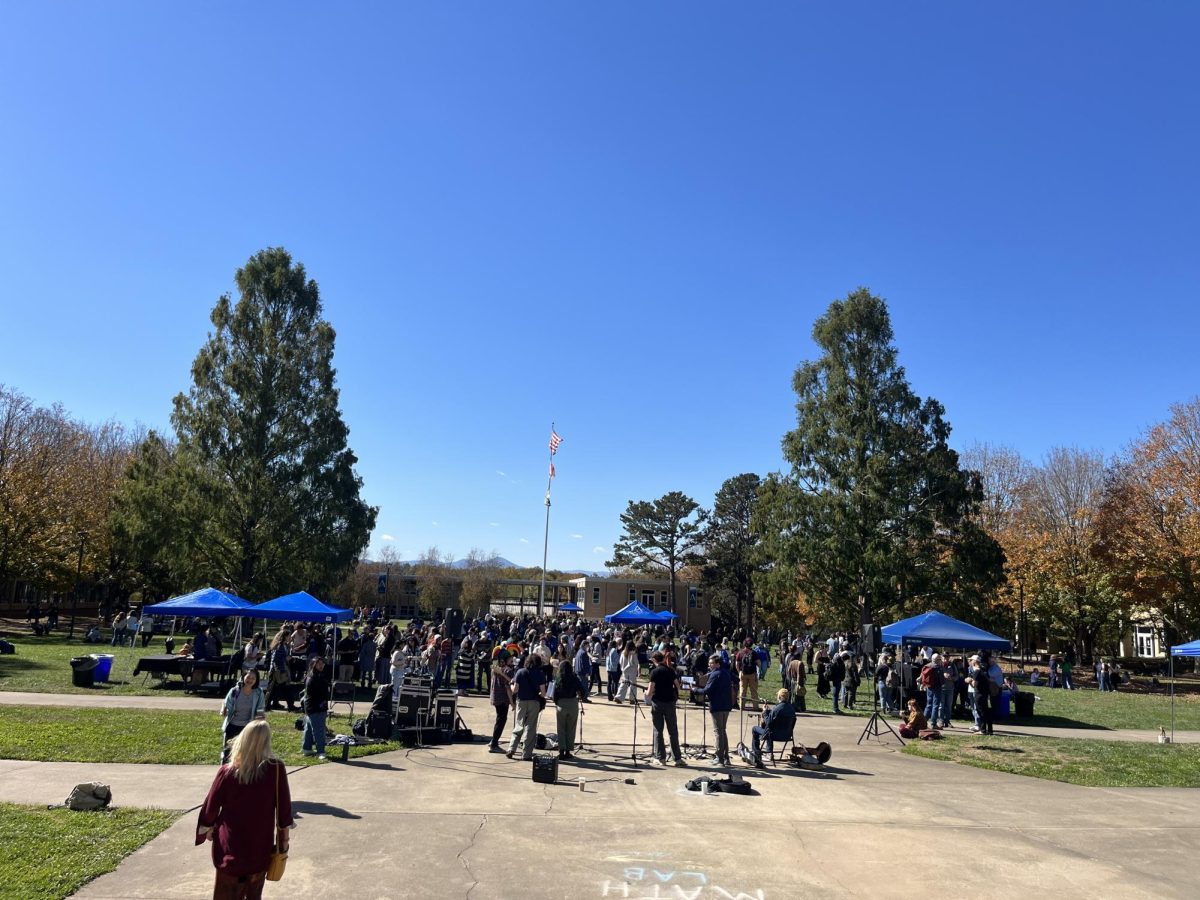Brooke Randle
News Writer
[email protected]
A campaign by UNC Asheville student organizations to implement an initiative, which aims at providing more food options to students, continues to face pushback from university administration on issues surrounding cost and practicality, leading to frustration among some student organizers.
The initiative, known as the Real Food Challenge, launched in 2008 as a collaboration between the California Student Sustainability Coalition and The Food Project, a Boston based nonprofit.
The movement, which now includes over 30 universities nationwide, encourages colleges to provide at least 20 percent “real food” to students on campuses. According to the Real Food Challenge’s website, “real food” constitutes as local, fair trade, ecologically sound and humanely sourced food.
Jenna Ventrella, co-president of Active Students for a Healthy Environment, points to a 2014 university-funded study which found only two percent of UNCA campus food meets these requirements.
“Right now, based on a 2014 study done by a student at UNCA, Chartwells is serving 2 percent real food on campus,” Ventrella said. “A lot of students don’t realize that.”
Ventrella, a health and wellness and environmental studies student, said ASHE, along with the Student Environmental Center and other student organizations, have been working with the Sustainability Committee and others within the administration to address student concerns regarding the Real Food Challenge for nearly four years. However, the initiative has been stalled due to disagreements among students and administrators.
“ASHE has been working on the Real Food Challenge since 2013. We’ve been sitting down with administration, dining and the sustainability office and it hasn’t been a conversation of collaboration,” Ventrella said. “We’re not saying that we have all of the answers or that we know how to get more real food on campus or make this program better, but we’re trying to sit down with dining and administration and see what we can do to work together but that’s not how it’s been going.”
Nineteen-year-old James Smith, divestment coordinator for UNCA Divestment, works with ASHE in promoting the Real Food Challenge.
“I’m super down with it because when people think of Asheville and our school, they think it’s very liberal, socially responsible and sustainable. Some of our actions on campus don’t reflect that entirely,” Smith, a chemistry and environmental studies student, said. “I’m just looking for across the board changes that reflect our school’s outward appearance.”
Mandatory meal plans

For Ventrella, part of the need for UNCA to join the initiative stems from her own experience with the meal plan requirement for freshmen living on campus.
“When I was here my first semester, I was eating at Brown quite frequently, like everyone else was and the food was making me feel kind of sick. I felt like it just wasn’t good quality,” Ventrella said.
Ventrella said she now buys most of her own groceries rather than using UNCA’s meal plan.
“Now, I spend upwards of $2,000 on a meal plan that I don’t use. I feel like a lot of students feel that way,” Ventrella said. “As a student, you don’t want to spend money on crappy food and not eat it. That’s why it’s important to me.”
Associate Vice Chancellor for Student Affairs Administration Nancy Yeager said many universities utilize meal plans similar to the ones found at UNCA. Yeager said meal plans help to promote student success and convenience.
“It’s a common model at universities,” Yeager said. “Students who live on campus have to be on a meal plan and it’s for a number of reasons. We find through research that students who live and eat on campus do better as far as persistence, GPAs and graduation rates. It also provides community for students and is part of the college experience.”
Yeager said the mandatory requirement for meal plans provides the financial backing which allows the program to be available to all students. Opting-out remains limited to students with dietary restrictions and other special circumstances.
“Most campuses don’t allow students to opt-out for financial reasons as well to be able to provide the program that we have. The way you can opt-out is only if you have a medical or dietary reason. Allergies, for example, would be an understandable reason,” Yeager said.
Weighing the costs
Smith said one of the biggest debates surrounding the Real Food Challenge revolves around the claim the initiative would lead to increases in tuition.
“From what I understand, it all comes down to money,” Smith said. “They’re saying that by implementing 20 percent ‘real food’ that tuition would go up and it would just be more expensive for students, which is certainly a valid argument.”
Yeager said the struggle lies in balancing the needs of students while keeping costs reasonable for students of all socioeconomic backgrounds.
“We’re very cost conscious and we try to be very competitive with other schools in the system,” Yeager said. “Considering what we do provide in terms of local, organic, vegan, gluten free, that’s not cheap to do. I don’t think people really understand the finances behind that.”
Yeager said providing additional organic, fair trade and humanely sourced items will have a direct impact on tuition rates. Student organizations have not concluded how much more they are willing to pay to cover the costs.
“Whenever you take on additional stuff, it does cost. And then if the students say ‘I’ll pay more,’ we have to ask, ‘Well, how much more?’ We have to ask those hard questions,” Yeager said. “Some people may think a dollar more is fine but $100 more? Maybe not. So we are very cost-conscious about what we do and we try to make sure it is the right decision.”
Organic food costs on average 47 percent more than conventional food, according to a 2015 Consumer Reports study. However, the study also concluded some items, including olive oil, carrots and cream cheese, could be found for the same price or cheaper than non-organic items.
Ventrella said ASHE and other student organizations have considered the price tag of so-called “premium” food items. Yet, she said there may be ways for the university to offset the price.
“I know a lot of students are concerned about the cost point, especially low-income students. It doesn’t have to cost more for students,” Ventrella said. “There are ways to cut costs in some areas so that you can then raise costs in other areas. Some of the product shifts that have happened, like fair trade coffee, have not escalated the cost of the meal plan by a lot and students are paying for that. Sometimes product shifts can save money as well.”
Making it happen
Director of Dining Services Brooks Casteel said another aspect preventing UNCA from meeting the Real Food Challenge standards lies in feasibility. Providing enough locally-sourced food to a student population of nearly 4,000 remains a challenge.
“A big thing is the volume. A local farm may have sweet potatoes for example, but they may only have a few cases available, whereas we need a very large amount,” Casteel said. “That’s something that we struggle with because it’s not like a restaurant where you need one case or one bag of something.”
Casteel said some foods are simply unavailable within the Western North Carolina region.
“Whether you’re in California or the mountains of Western North Carolina, they’re two very different growing seasons. So, what you have available to you can be very different,” Casteel said. “We don’t have to do something that isn’t going to be great. We can do something great, but let’s do something that can be realistically be accomplished within our region.”
Smith, acknowledging the practicality side of food buying, said there are still many things the university can do to make the climb to 20 percent.
“I think out of 100 percent of food that we eat on campus, we could find 20 percent of things we eat that could be grown locally,” Smith said. “Obviously, it can’t be oranges but there are plenty of other things that can be done that aren’t being addressed right now. That’s one-fifth of the food we’re eating. I definitely think it’s possible.”
Defining “real food”
UNCA’s Registered Dietician for Dining Services Laura Sexton said the words “real food” may have different meanings to different students.
“Looking at a college and university model, it’s definitely a spectrum. What people view as healthful foods is going to be different from person to person,” Sexton said. “Since I work with such a multitude of students who have such different dietary preferences, I have to really be realistic in what I say, not based on my own dietary preferences or the idealistic way of eating.”
Sexton said the food UNCA provides does reflect a difference in attitude surrounding healthy food compared to other universities.
“When I came on to campus and saw that we don’t even have a corporate fast food vender on campus, I was shocked,” Sexton said. “There are students who are already there and are already very healthy eaters and that’s great, but not everyone is there yet.”
Yeager said the 2014 study claiming UNCA only provided two percent “real food” may mislead students.
“When people just throw out that term ‘real food,’ it’s kind of a misnomer I think,” Yeager said. “Everybody wants to eat real food, but how are you defining it? I think that that’s one of the places where it keeps getting stuck and one of the issues that our students have had.”
Casteel said by the Real Food Challenge standards, most of the food on campus would be ineligible because the definition of “real food” consists of very narrow guidelines. Deciding what is or is not local food, for example, illustrates the subjectiveness of the issue.
“Local, depending on who it’s defined by, could be 100 miles or 200 miles or 250. It really just depends and if you’re talking about 100 to 150 miles radius, that’s pretty limiting in our region,” Casteel said. “Would it be better to get an orange from Florida rather than California? Yes. So again, it doesn’t exactly fit into this one group’s particular framework, but on a larger scale, it’s better to source regionally than nationally.”
Casteel said the “real food” items at UNCA has grown since the 2014 study and fluctuates with the changing seasons. UNCA currently offers fair trade coffee and tea as well as local sweet potatoes, kale and apples. One hundred percent of apples were locally sourced during September through January of this year, Casteel said.
Looking ahead
As students and administrators face the issue of adding more food options on campus, both groups agree increased student engagement of the issue will yield the biggest change and compromise.
Smith said students must first consolidate their needs among the student body to better communicate with administration.
“Obviously, any type of negotiating is hard, especially with a lot of parties, but I definitely get the sense that the administration does want to work with students,” Smith said. “From a student’s perspective, I think it’s good to understand where the administration is coming from and how to work in and outside of that toward a goal. It’s definitely a challenge, but I’d like to see that happen for sure.”
Ventrella said while she acknowledges the efforts of administration officials, communication and student involvement will be key in understanding the needs of students.
“Dining has done some good things. I don’t want to completely discredit them. We just need more students to get involved, because students are going to be the voice of this campaign,” Ventrella said. “We have meetings every Tuesday in Karpen Hall and we just talk about strategies. Basically, just looking up our group on Facebook and going to our meetings are a great way to get involved.”
Yeager echoed the need for feedback and student participation in making important decisions.
“We don’t want to shut down the dialogue,” Yeager said. “We want students to push us and ask us questions and let us know about their ideas, because that’s part of the learning experience is listening to the students. The door is always open.”


















